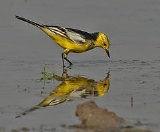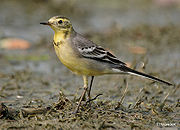
Citrine Wagtail
Encyclopedia
The Citrine Wagtail or Yellow-headed Wagtail (Motacilla citreola) is a small songbird
in the family
Motacillidae
. The term citrine
refers to its yellowish colouration. Its systematics
, phylogeny and taxonomy
are subject of considerable debate in the early 21st century. This is because this bird forms a cryptic species complex
with the Yellow Wagtail (M. flava). Which of the many taxa in this group should properly refer to which population
is unlikely to be resolved in the immediate future.
 It is a slender, 15.5–17 cm long bird, with the long, constantly wagging tail characteristic of the genus
It is a slender, 15.5–17 cm long bird, with the long, constantly wagging tail characteristic of the genus
Motacilla. The adult male in breeding plumage is basically grey or black above, with white on the remiges, and bright yellow below and on the entire head except for the black nape. In winter plumage, its yellow underparts may be diluted by white, and the head is brownish with a yellowish supercilium
. Females look generally like washed-out versions of males in winter plumage.
This species breeds in north central Asia
in wet meadows and tundra
. It migrates
in winter to south Asia
, often to highland areas. Its range is expanding westwards, and it is a rare but increasing vagrant to western Europe
. Vagrants seem to extend the migration rather than straying en route; in Bhutan
for example, though along one of the species' migration flyway
s, the Citrine Wagtail has been recorded as an extremely rare passer-by rather than staying even for a few days or weeks.
It is an insectivorous bird
of open country near water, such as wet meadows and bogs, and nests on the ground, laying 4-5 speckled eggs.
Songbird
A songbird is a bird belonging to the suborder Passeri of the perching birds . Another name that is sometimes seen as scientific or vernacular name is Oscines, from Latin oscen, "a songbird"...
in the family
Family (biology)
In biological classification, family is* a taxonomic rank. Other well-known ranks are life, domain, kingdom, phylum, class, order, genus, and species, with family fitting between order and genus. As for the other well-known ranks, there is the option of an immediately lower rank, indicated by the...
Motacillidae
Motacillidae
The Motacillidae are a family of small passerine birds with medium to long tails. There are around 65 species in 6 genera and they include the wagtails, longclaws and pipits. The longclaws are entirely restricted to the Afrotropics, and the wagtails are predominately found in Europe, Africa and...
. The term citrine
Citrine (colour)
Citrine is a colour, derived from coloured varieties of quartz, and variously described as yellow, greenish-yellow, brownish yellow or orange. Actually, as can be ascertained by inspecting its h value, citrine is a medium dark shade of golden yellow...
refers to its yellowish colouration. Its systematics
Systematics
Biological systematics is the study of the diversification of terrestrial life, both past and present, and the relationships among living things through time. Relationships are visualized as evolutionary trees...
, phylogeny and taxonomy
Taxonomy
Taxonomy is the science of identifying and naming species, and arranging them into a classification. The field of taxonomy, sometimes referred to as "biological taxonomy", revolves around the description and use of taxonomic units, known as taxa...
are subject of considerable debate in the early 21st century. This is because this bird forms a cryptic species complex
Cryptic species complex
In biology, a cryptic species complex is a group of species which satisfy the biological definition of species—that is, they are reproductively isolated from each other—but whose morphology is very similar ....
with the Yellow Wagtail (M. flava). Which of the many taxa in this group should properly refer to which population
Population
A population is all the organisms that both belong to the same group or species and live in the same geographical area. The area that is used to define a sexual population is such that inter-breeding is possible between any pair within the area and more probable than cross-breeding with individuals...
is unlikely to be resolved in the immediate future.

Genus
In biology, a genus is a low-level taxonomic rank used in the biological classification of living and fossil organisms, which is an example of definition by genus and differentia...
Motacilla. The adult male in breeding plumage is basically grey or black above, with white on the remiges, and bright yellow below and on the entire head except for the black nape. In winter plumage, its yellow underparts may be diluted by white, and the head is brownish with a yellowish supercilium
Supercilium
The supercilium is a plumage feature found on the heads of some bird species. It is a stripe which runs from the base of the bird's beak above its eye, finishing somewhere towards the rear of the bird's head. Also known as an "eyebrow", it is distinct from the eyestripe, which is a line which runs...
. Females look generally like washed-out versions of males in winter plumage.
This species breeds in north central Asia
Asia
Asia is the world's largest and most populous continent, located primarily in the eastern and northern hemispheres. It covers 8.7% of the Earth's total surface area and with approximately 3.879 billion people, it hosts 60% of the world's current human population...
in wet meadows and tundra
Tundra
In physical geography, tundra is a biome where the tree growth is hindered by low temperatures and short growing seasons. The term tundra comes through Russian тундра from the Kildin Sami word tūndâr "uplands," "treeless mountain tract." There are three types of tundra: Arctic tundra, alpine...
. It migrates
Bird migration
Bird migration is the regular seasonal journey undertaken by many species of birds. Bird movements include those made in response to changes in food availability, habitat or weather. Sometimes, journeys are not termed "true migration" because they are irregular or in only one direction...
in winter to south Asia
Asia
Asia is the world's largest and most populous continent, located primarily in the eastern and northern hemispheres. It covers 8.7% of the Earth's total surface area and with approximately 3.879 billion people, it hosts 60% of the world's current human population...
, often to highland areas. Its range is expanding westwards, and it is a rare but increasing vagrant to western Europe
Europe
Europe is, by convention, one of the world's seven continents. Comprising the westernmost peninsula of Eurasia, Europe is generally 'divided' from Asia to its east by the watershed divides of the Ural and Caucasus Mountains, the Ural River, the Caspian and Black Seas, and the waterways connecting...
. Vagrants seem to extend the migration rather than straying en route; in Bhutan
Bhutan
Bhutan , officially the Kingdom of Bhutan, is a landlocked state in South Asia, located at the eastern end of the Himalayas and bordered to the south, east and west by the Republic of India and to the north by the People's Republic of China...
for example, though along one of the species' migration flyway
Flyway
A flyway is a flight path used in bird migration. Flyways generally span over continents and often oceans.-Flyways of the Americas:*Atlantic Flyway*Central Flyway*Mississippi Flyway*Pacific Flyway*Allegheny Front...
s, the Citrine Wagtail has been recorded as an extremely rare passer-by rather than staying even for a few days or weeks.
It is an insectivorous bird
Bird
Birds are feathered, winged, bipedal, endothermic , egg-laying, vertebrate animals. Around 10,000 living species and 188 families makes them the most speciose class of tetrapod vertebrates. They inhabit ecosystems across the globe, from the Arctic to the Antarctic. Extant birds range in size from...
of open country near water, such as wet meadows and bogs, and nests on the ground, laying 4-5 speckled eggs.

